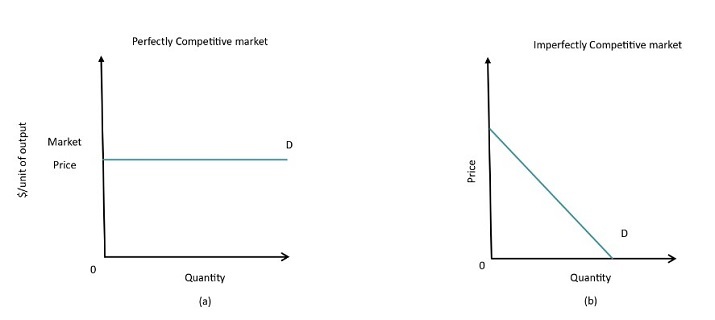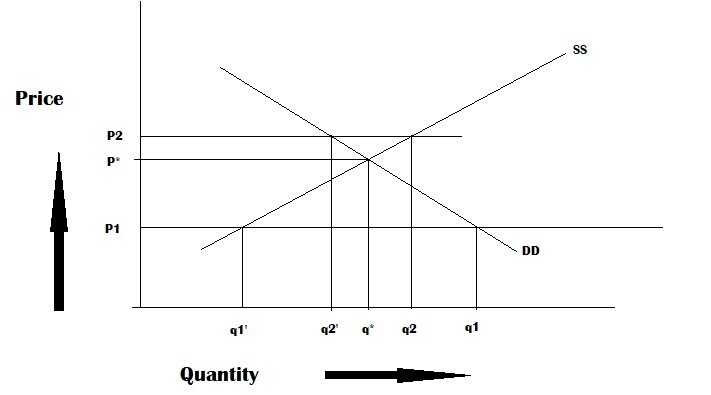
 Data Structure
Data Structure Networking
Networking RDBMS
RDBMS Operating System
Operating System Java
Java MS Excel
MS Excel iOS
iOS HTML
HTML CSS
CSS Android
Android Python
Python C Programming
C Programming C++
C++ C#
C# MongoDB
MongoDB MySQL
MySQL Javascript
Javascript PHP
PHP
- Selected Reading
- UPSC IAS Exams Notes
- Developer's Best Practices
- Questions and Answers
- Effective Resume Writing
- HR Interview Questions
- Computer Glossary
- Who is Who
Market Equilibrium Fixed Number of Firms
Introduction
It is important to look at the theoretical implications of market equilibrium when the number of firms is fixed in a market. Although it is a hypothetical situation, the findings from the theory are applicable in real life. That is why looking at the findings of the situations when a number of firms are fixed in the market is indispensable for understanding the outcomes of real-life markets. This tutorial discusses the propositions of market equilibrium when the number of firms is fixed.
What is Market equilibrium?
Market equilibrium is a market condition where the market's demand and supply balance each other. There are two situations that can occur in a market - oversupply, and over-demand. Usually, when over-supply occurs in the market, the prices go down which increases the demand. In the case of over-demand in the market, the prices go up which decreases the demand. Therefore, the market adjusts itself to remain in balance which is known as market equilibrium.
The price at which supply meets the demand in a market is known as the equilibrium price. We can understand market equilibrium by noticing the market indices. The periodic consolidation of an index or its sideways momentum indicates market equilibrium over a certain period of time.
The prices of a product often hover over the equilibrium price level in a market. When the prices go too down to the equilibrium price, buyers buy products more than usual which increases the demand while in the case of a price rise, the buyers buy less, and hence price comes down.
How Price is determined in a Perfectly Competitive Market with Fixed Number of Firms

In a perfectly competitive market, the price of a product is determined by the market forces of supply and demand. Market supply of a market is the total supply of products required to meet the needs of the market whereas market demand refers to the overall demand required to meet the needs of the market completely. The market demand and supply curves are used to predict the equilibrium price of a product in a given market. The equilibrium price is the price at which market demand and supply intersect each other. At the point of market equilibrium, market demand equals market supply.
The forces of demand and supply in a market are popularly termed the invisible hand that controls the markets. It is known that in a market economy or a free market, there is no restriction to set prices for products and so companies can set aunty price for theory products. However, there is a reason why they cannot do so.
The reason is the control by the invisible hand. If the companies increase the price, customers will shift to products that are identical but cost less, so the demand for the product will go down. So, the company will need to reduce the price to increase the demand again.
It must be noted that a market reaches and stays at the exact equilibrium point hardly. The price usually keeps fluctuating below and above the equilibrium point. This however does not affect the decision-making process of producers because a little bit less or more of production does not impact hard enough to profitability.
It is, therefore, notable that the market equilibrium for a fixed number of firms is a matter of theory because perfect equilibrium is only possible to achieve in theory. However, that does not affect the overall condition of the market because producers take the cues and adjust the prices even when a perfect equilibrium has not been reached.
Diagram: Market equilibrium for a fixed number of firms

As mentioned above, we determine the equilibrium price of a product by taking the point of intersection of demand and supply curves for a market where the number of firms is fixed. The graph above shows the relationship between demand and supply in a perfectly competitive market where the number of firms is fixed.
In the graph above SS is the supply curve for a commodity and DD is the demand curve for it. SS expresses the amount of supply firms would wish to make in the market while DD indicates the demand for the product in the market. Thus, DD shows the amount of commodity consumers will prefer to buy at any instant while SS shows the amount of product the producers would be willing to sell at any certain point in time.
The graph shows the equilibrium point where the demand curve meets the supply curve, i.e. the point of intersection of the two curves because this is the point where market demand equals supply. At all other points, there is either an over-supply or there is over-demand.
When the price is P1, the demand is q1 and the supply is q1'. So, there is an over demand of q1q1'. There will be some consumers in the market then who would be unable to procure the item at any cost. They will be willing to pay more price for the items. So, the demand for the item will go up.
The market price will then increase and reach a point P* where the demand and supply would intersect with each other. This happens because when everything else remains constant, the demand decreases and the amount supplied increases. This leads to a point where the quantity the buyers demand tends to be equal to the supply the suppliers tend to sell. At point P*, the demand decisions made by buyers equal the supply decision taken by producers, and this is known as the market equilibrium position of the product in a given market.
At point P2, there will be an over-supply where the given supply (q2) will exceed the quantity that is demanded by the consumers (q2') at the given price P2. Therefore there will be an excess supply of q2q2'. At that point, many firms will not be able to sell the products at the price they want to sell, so there will be a lowering of price from these products.
Now, when everything else remains constant, with the prices going down, the demand for the product increases. The supply of quantity goes down and at P* the firms become able to sell the desired amount of products. So, P* is the equilibrium price in a market equilibrium with a fixed number of firms while q* is the corresponding demand at that point in time.
Conclusion
Theoretically, it is possible to check the conditions of a market when the number of firms is fixed. It shows the effects of market forces of demand and supply acting in a market and the outcomes of such interactions. It is therefore useful for the firms to understand market equilibrium for a fixed number of firms in order to ascertain situations in other forms of markets.
FAQs
Qns 1. What is market equilibrium? Discuss briefly.
Ans. Market equilibrium is a market condition where the market's demand and supply balance each other. There are two situations that can occur in a market - oversupply, and over-demand. Usually, when over-supply occurs in the market, the prices go down which increases the demand. In the case of over-demand in the market, the prices go up which decreases the demand. Therefore, the market adjusts itself to remain in balance which is known as market equilibrium.
Qns 2. How is the price determined in a perfectly competitive market with a fixed number of firms?
Ans. In a perfectly competitive market, the price of a product is determined by the market forces of supply and demand. Market supply of a market is the total supply of products required to meet the needs of the market whereas market demand refers to the overall demand required to meet the needs of the market completely. The market demand and supply curves are used to predict the equilibrium price of a product in a given market.
Qns 3. Why is the hypothetical consideration of market equilibrium for a fixed number of firms important?
Ans. The hypothetical consideration of market equilibrium for a fixed number of firms is important because it offers an idea about real market considerations of market forces.

